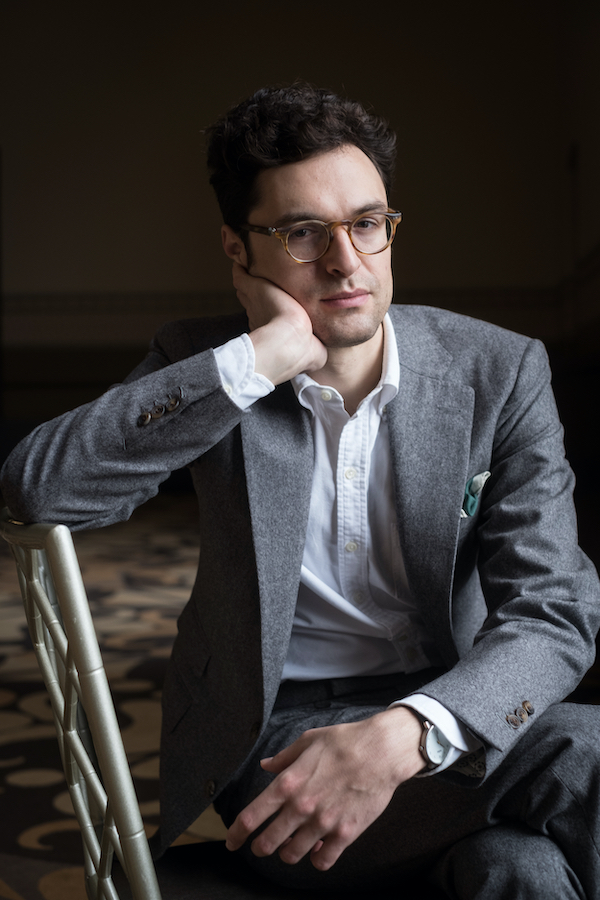New World wraps year with imaginative chamber program

With the seating area around the stage at the New World Center still decorated in wreaths and holiday lights from its seasonal weekend programs, the New World Symphony concluded the year with a typically adventurous chamber music program Sunday afternoon.
Two contemporary composers were on hand to introduce their works. French and German rarities cleansed the musical palette and an electrifying performance of a Brahms masterwork comprised the imaginative bill of fare.
The Distant Wind II for clarinet and strings by Orlando Jacinto García, a professor of composition at Florida International University, was a study in spare, quiet motifs and wispy timbres. Opening with the clarinetist breathing into the instrument, the eerie sounds of wind chimes and tuned water glasses provide the work’s most striking moments. Clarinetist Angelo Quail’s mellow sound and adroit breath control (which was put to the test in Garcia’s long, winding phrases) carried the lead voicings. An eighteen-member string contingent provided the evocative backdrop. Like the works of Morton Feldman, García’s mentor, the score moves at a glacial pace, and its fourteen-minute duration seemed considerably longer.
If García’s music was a snooze for many in the audience, Timo Andres’ Tides and Currents was a wakeup call. Commissioned and premiered by the New World Symphony in 2016, the work’s title references the ocean waves off the shore of Miami Beach that some feel may eventually engulf the island. Scored for two pianos and percussion, Andres’ vignette whirls in minimalist rhythmic patterns, often at top volume. Crafted with considerable ingenuity, jazz and boogie-woogie make subtle appearances in Andres’ hothouse musical brew.
Thomas Steigerwald and Wesley Ducote brilliantly handled the lightning keyboard lines. Playing timpani, gong, mallet instruments and a variety of percussion, Kevin Ritenauer and Charlie Rosmarin were just as prominent and stunning in sheer dexterity.
The score was given an immersive environmental presentation. Patterns of waves and ocean plant life were projected on the screens above the hall’s stage and side walls. Alternately blue and green stage lighting surrounded the performers. Partly because of the work’s cinematic flow, these visual elements did not prove a distraction. Andres received cheers and loud applause from the audience. He is an important, rising compositional voice.
Charles Koechlin (1867-1950) was a pupil of Massenet and Fauré. His Primavera quintet spotlights the flute and harp combination that Debussy and Ravel successfully utilized. Brimming with Gallic charm, the last of the suite’s four movements is particularly notable for Bachian counterpoint and fugal writing. The work abounds in sparkling invention that conveys the joy of the first rustle of spring.
Flutist Jack Reddick captured the music’s lightness of spirit but his tone turned slightly harsh at times. Whether tracing the austere thematic paths of the Adagio or elegantly assisting Reddick’s flute role, harpist Chloe Tula’s tonal gleam and adroit balancing took special honors. The amber tones of Stephanie Block’s viola, Chelsea Sharpe’s tangy violin solos and Drew Comstock’s deep cello sonority added zest to the score’s bright ambience.
German composer Oskar Böhm (1870-1938) emigrated to Russia where he had a successful career as a pedagogue and orchestral player before falling victim to Stalin’s purges. He was imprisoned and, apparently, executed, his music largely forgotten.
Böhm’s Nachtmusik for brass was recently discovered and may be his last work. The opening Nocturne is a veritable Christmas chorale and the gently rocking Barcarolle would make a great pops concert cameo in an orchestral transcription. This is unpretentious entertainment music and it was given a rounded and sonorous reading by Gianluca Farina and Rebecca Olivero, trumpets; Guangwei Fan and Arno Tri Pramudia, trombones and Lisa Stoneham, bass trombone.
Brahms’ String Quintet No. 2 in G Major completed the afternoon in bracing fashion. From the initial string tremolo and cellist Alan Okubo’s bold phrasing of the opening subject, it was obvious that this was not going to be a “play it safe” performance. The players’ distinct timbres were allowed to stand out and there was storm and friction in their tonal shading as well as moments that caressed the ear.
Violinists Tara Lynn Ramsey and Teddy Wiggens’ supple rendering of the melancholy theme in the second movement kept the intensity at high pitch despite the slow tempo. The final Vivace, one of Brahms’ Hungarian-tinged closers, was dashed off with unhinged velocity. Violists Spencer Ingersoll and Jessica Pasternak added dark Brahmsian undertow. While some of the expressive depths of this autumnal score went unexplored, the players’ strong technique and the sheer excitement generated by their playing carried the day.
Juanjo Mena conducts the New World Symphony in Berlioz’s Overture to Benvenuto Cellini, the Mussorgsky-Ravel Pictures at an Exhibition and Saint-Saëns’ Piano Concerto No. 5 (“Egyptian”) with soloist Jean-Yves Thibaudet 8 p.m. January 11, 2020 at the Arsht Center in Miami. nws.edu; 305-673-3331
Posted in Uncategorized
Leave a Comment
Mon Dec 23, 2019
at 1:45 pm
No Comments






